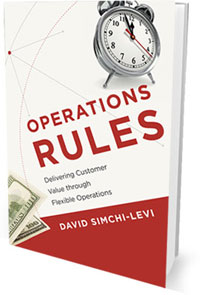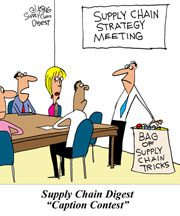 |
February 16, 2012 - Supply Chain Newsletter |
 |
This Week In SCDigest
FEATURED SPONSOR: Seagull Scientific |
To securely search through detailed logs of |

Metrics Strategies and Supply Chain Performance
|
|||||||||||||||||||||||||
| GILMORE SAYS: |
"I look at what Sara Lee is doing, and I just don't see how it could get very far off course for very long." WHAT DO YOU SAY? |
In fact, I often hear various pundits say the problem in many organizations is that there are too many metrics. Meaning, by trying to measure everything, you lose sight of those few that really matter.
I agree there are probably cases where there "too many metrics" syndrome is true, but I am not so sure that having detailed, interlinked metrics up and down the supply chain isn't a good thing. Below are just a few impressive examples of what companies are doing with supply chain metrics that I think illustrated where a growing number of companies are today:
A year or so ago I saw a presentation from a Sara Lee supply chain manager that was nominally on its Sales & Operations Planning process - which seemed excellent enough - but what blew me away a lot more was the goal and measurement process behind it. It was really more of an "integrated business planning" type approach versus traditional S&OP, and all the key financial and operational goals were cascaded down multiple levels, with direct linkages back to the top - "line of site metrics," as it is called. Truly integrated performance management, assuming they walked the talk.
Spoke with a supply chain executive at network equipment giant CISCO around the same time, and it is just amazing what all it measures across its supply chain. It would take several columns to do close to justice to how it has instrumented its network, but to cite a quick example, CISCO has developed a number of strategies and tactics to enhance it supply chain flexibility (e.g., a "range forecasting and planning" process by SBU, product family, and individual SKU), and it then creates detailed reporting as to how well those strategies are working - and being used.
At the sort of other end of the spectrum, but illustrating the same basic theme, Procter & Gamble closely tracks what it calls something like "Cases not shipped because of warehouse." That refers to situations when cases are shorted on an order/shipment that were actually in the DC. When that happens, lots of alarm bells start going off, and the warehouse manager gets real nervous. If it happens more than a few times, he or she can expect a visit from the experts in Cincinnati.
I hear these sort of metric stories over and over again now - far different than even five years ago. Virtually every supply chain related case study now includes a detailed "what were the metrics" component. Part of it all this also comes from increasingly capable and integrated IT systems.
So my point is: how, with this level of reporting, can companies possibly go off the supply chain rails? How can there continue to be such wide gaps between the performance leaders, the average, and the laggards, as most recent studies have found there to be?
I mean, I look at what Sara Lee is doing, and I just don't see how it could get very far off course for very long. It seems to be measuring everything, directly tied to its overall goals and objectives. I suppose we could propose that it and other companies don't take those metrics and goals seriously, letting failure to hit the goals continue to just slide, but I just can't believe that is true in the vast majority of cases today, as it might have been in the past.
So, I am left with two choices:
1. Too many companies are being rigorous around the wrong metrics. They are hitting their metrics, but they are the wrong measures.
2. The right metrics are largely in place. But the targets are set at the wrong levels.
 My friend Jim Tompkins of Tompkins International has some interesting things to say about number 1, but I am going to hold that for a future column. But I will say his and my thoughts on what should be the right metrics to use is in the end closely relate to point number 2. Too many companies must simply be setting their targets too low.
My friend Jim Tompkins of Tompkins International has some interesting things to say about number 1, but I am going to hold that for a future column. But I will say his and my thoughts on what should be the right metrics to use is in the end closely relate to point number 2. Too many companies must simply be setting their targets too low.
Who, if anyone, talks to a company in this era that says it is consistently missing its supply chain targets? You last today how many quarters as VP of Supply Chain or a functional manager if that is the case? About two, from what I see. Three quarters if you are really lucky.
So, that would seem to say that companies are not missing their metrics by much or for long. Leaving the logical conclusion that the difference in supply chain performance between similar companies is that they have set different targets, some of them way to low.
I will acknowledge that some difference in targets and thus results could - and often should - be related to different value props, such as whether the company's main differentiation is based on product innovation, cost or service, using the famous and still used framework promoted in the book "The Discipline of Market Leaders" more than a decade ago, by Michael Treacy and Fred Wiersema.
If service is your thing, than obviously metrics like fill rates, cycle times, etc. would have more focus than cost-related metrics (yes, we could debate whether this holds up in practice).
More recently, the concept of supply chain segmentation has re-emerged, and one of the fundamental principles of this strategy is that the supply chain metrics that matter will be different for the different segments being served with differentiated supply chain strategies and service policies.
I must admit in examples such as Sara Lee, CISCO and others that I didn't hear any discussion of segmented metrics, or how their main overall value prop impacted metric targets.
So in general, I am sticking with my conclusion that likely the main driver of supply chain performance between companies is that the leaders set much higher expectations than the middle and the laggards. The driver of performance difference isn't the wrong metrics, or the inability to hit the targets, but that the targets are simply set too low.
After all, how do you really know what the targets should be? More on that, and Dr. Tompkins interesting framework, in a couple of weeks.
What are your thoughts on the relationship between metrics, reporting, and performance? Do you agree with Gilmore's conclusion that the key difference in performance between similar companies often may be that the targets set are very different? Let us know your thoughts at the Feedback button below.
![]()
Supply Chain Graphic of the Week:
|
|||
CARTOON CAPTION CONTEST WINNER ANNOUNCED!January 31, 2012 Contest
|
|||
ONTARGET e-MAGAZINEWeekly On-Target Newsletter:
|
|||
|
|||
THIS WEEK ON
|
|||
NEW EXPERT CONTRIBUTOR
By Stephen Gerrard |
|||
SUPPLY CHAIN TRIVIAWhat was the connection of Roger Milliken, founder and long-time CEO of textile giant Milliken & Company, to the supply chain from the mid-1980s through some of the 1990s?Answer Found at the Bottom of the Page |
|||
Tuesday's Videocast:
B2B Buyers Issue a SoMoLo Imperative

Consumers' Social, Mobile and Local Shopping Behaviors Are Now Impacting B2B Buying Cycles in a Big Way
Featuring David Bruno, Director of Commerce Studies, RedPrairie
Upcoming Videocast:
Managing Risk in a Multi-Tier Supply Chain

Look Beyond Tier One Suppliers to Lower Risk, Optimize Costs, and Enhance Resiliency
Featuring Tom Linton, SVP and CPO, Flextronics; Thomas Choi, Professor of Supply Chain Management at Arizona State University, School of Business; and Rich Becks, General Manager, High Technology, E2open
Upcoming Videocast:
Operations Rules for Driving Business Value & Growth

Part 1: Mitigating Business Risks from the Known-Unknown to the Unknown-Unknown
Featuring Prof. David Simchi-Levi of MIT
More feedback this week on our late recognition of the death last year of Dr. Eli Goldratt, founder of the Theory of Constraints. Feedback of the Week - On Eli Goldratt: |
||
Following your excellent article, I wanted to share an experience with you that I will never forget about Eli Goldratt. A salesman's storyI spent 6 years working with Eli and all our colleagues in the UK and without doubt this time changed the entire direction of my life. But I want to share one story, of the time Eli, Oded Cohen and I spent a day with a large UK engineering company - a memory that will stay with me very fondly forever. We had set up a whole day of presentations and meetings, starting with a presentation by Eli of The Competitive Edge (later called The Race) to 35 MDs and Manufacturing Directors. It went fantastically well. Then we had a straight on meeting with the Group FD. Not brilliant but good. Then lunch with the Board (7 of whom had all been to the same private school in the UK - this was very, very English). Aside from the clash of cultures (suits and ties versus open neck shirt, cigar and yamulka!), lunch was good. Then the finale - a presentation of The Competitive Edge by Eli to The Board. I set up the acetates (long before Powerpoint), turned on the projector, introduced Eli, who then decided to turn it off again and pick an intellectual fight with the Chairman for an hour. Eli was rightly of the view that his company was, in every TOC way, inefficient. As one of the other directors said to me on the way out, "He is right, of course, but maybe there was a better way to say it!" There was a ban on even mentioning Eli's name for a month, but then 6 months later, we signed a deal and proved Eli's point. I will certainly never forget the day or the drive home! Hugh Williams
|
||
More on Goldratt:
|
||
Thank you for repeating this interview. I remember that back in 2006 Goldratt Consulting offered only eight templates as solutions. Six years after, and with the guidance of Dr. Goldratt in his last years, Goldratt Consulting is offering a solution to every company. Of course in many cases there is no off the shelf solution, but in few weeks an analysis can develop a breakthrough solution for the clients. Another thing that it is different is the offer. It is no longer 'net profit to current sales in four years or less' as read in the interview. That was unrealistic in some cases and it was not a challenge in other cases. Today the offer is to build a system to increase both stability and growth beyond all current expectations of executives of the company. Yes, I had the fortune to meet and work with Dr. Goldratt. He made me think bigger and farther. I came to understand the old statement of Socrates (all I know is I know nothing) with TOC. I knew the phrase but I didn't understand it. Once i understood what that means, the way ahead is always challenging and rewarding. Thanks again for bringing us once more the thoughts of a great man. Matias Birrell
|
||
Thank you for writing such a nice article on our friend Eli. I was fortunate to have had a relationship with Eli going back to the mid 1990's. I will guess that when you met with Eli you may have realized that Eli was about so much more. A simple web search will provide you with thousands of examples in just how much more, in business and personally in people's lives. More importantly one will find hundreds of stories from people sharing how Eli had such an impact in their lives, their communities, their countries, and in their schools. Eli accomplished many things in his lifetime and his accomplishments have most always included many other people. Some examples are in project management, throughput accounting, management skills, and how to strategically drive operational excellence into marketing and sales. I truly believe that even with all the success that has sprouted from Eli's life's work, the best is still forever in front of us. Thank you for this forum. Rocco SuraceManaging Partner GainesKrinerElliott
|
||
SUPPLY CHAIN TRIVIA ANSWER
Q: What was the connection of Roger Milliken, founder and long-time CEO of textile giant Milliken & Company, to the supply chain from the mid-1980s through some of the 1990s?
A: He was the leading and vocal champion of the Quick Response movement, aimed at speeding the replenishment of apparel goods to store floor through collaboration, bar coding, EDI and process changes. Milliken hoped this speed-based approach would keep American apparel manufacturers competitive with offshore suppliers. Unfortunately, for a variety of reasons, the end goal really wasn't achieved, though many of the core principles are being practiced today.
| © SupplyChainDigest™ 2003-2012. All Rights Reserved. SupplyChainDigest PO Box 714 Springboro, Ohio 45066 |
POWERED BY: XDIMENSION |




